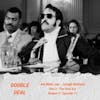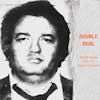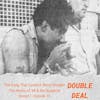
Conman to Armorer - Roy Appleton - The Early Years

In Episode 4 we will be discussing Roy Appleton. The man who from his grave would be the beginning of the end for former FBI SA, H. Rico. Rico who spent his final days in prison, just as many of the men he put away. Nina and Lara will tell you about Roy's early days.
If you'd like to email Lara you can reach her at lara@doubledealpodcast.comand Nina can be contacted at nina@doubledealpodcast.com
You can find us on Facebook, Instagram and Twitter.
Thank you for listening!
All the best,
Lara & Nina
Lara:
Hi! Nina and I are back this week to talk about Harold Leroy Appleton. I have fond memories of Roy. I used to look forward to trips with dad to Roy’s house. He reminded me of Abe Vigoda. His home was drastically different from the pristine English Tudor I lived in. There were books and magazines stacked everywhere, a rusty looking shag carpet, blind poodles and his lovely wife, Ann. Disarray ruled the day. Dad and Roy would go off in the corner to conspire, and I would play with the little poodles and chat with Ann. The cigarette smoke was so thick in the room that it looked like fog to me. Uncle Roy seemed like any other old man. It wasn’t until I was much older that I learned that Roy was anything but ordinary.
Nina:
Like Jack would pick anybody ordinary to work with!
Lara:
Well, he did have a unique crew! Talk about herding cats! Sure, they were at the top of their game, but their personalities must have been a nightmare to deal with.
Nina:
No question!
Lara:
Ok. Before we get into this episode, I want to give a disclaimer of sorts. Now that we’re delving deeper into dad’s world, I want to clarify a few things about what and who we’ll be discussing. Although most of the people are deceased, their family members might be listening at some point. There was never a time in my life that I didn’t know my dad was a thief, but it wasn’t until January of 2002 that I realized he was an informant. An informant for 40 years. The news was delivered to me via the metro section of the Boston Globe. I should have known because at various times, I saw dad speaking with law enforcement officers. Sometimes even at my home. Dad was dad. No matter what, he was my father, and he didn’t shelter me from the realities of his world. I didn’t ask, it just was what it was. But I understand that others may not know much about their loved one’s street lives. Most of these men were good family men, and for their kids and grandkids, that’s what was and should be the most important thing. That being said, much, if not most, of what we’ll be discussing can be found in newspaper archives or through the FOIA. Anecdotes, my own recollections, Richie’s stories and our theories aside, what we’re talking about is public information. But there are a couple of people who were informants that were never outed. Although my suspicions were confirmed in the FBI 302s, their names have never been released in the news, so out of respect for their families, I won’t be disclosing their informant status. This does not apply to Roy necessarily, but I wanted to put that out there now rather than later. Nina and I have compiled a list of FBI informant numbers in Boston that makes my head spin. It seems like there were more informants than Feds at times.
Nina:
I think there were! The numbers range from the mid-600s to the mid-1900s. That’s 1300 informants. The dates of the reports range from the mid-1950s to the early 1970s. Some of these people were eventually placed in the Witness Protection Program. The most famous of these was Vinnie Teresa.
Lara:
Vinnie seemed to have inserted himself into every crime that was committed in the northeast! He would have had to have a half dozen clones running around the street to be able to be in that many places at one time!
Nina:
I’m just imagining six Fat Vinnies running around the northeast!
So a few of those numbers were actually wiretaps, and not individuals. In one case, they installed a wiretap in a hotel room to find out what a mobster from New York was doing in town. That was a one time deal. The Feds added an asterisk to the end of the number to differentiate between the two. For example, there was a wiretap running at Mob Boss Raymond Patriarca’s place on Atwells Ave in Providence starting in March 1962. That was coded as BS-837-C*. BS was the code for Boston and the surrounding area, including Providence. There was another wiretap running at Jerry Anguilo’s place that was installed in January 1963. That was given the code: BS-856-C*. Supposedly both of those wiretaps were cut off on the same day in mid-July 1965. But I still have my doubts about that.
Lara:
The most frustrating thing about the wiretaps is that only a summary of the conversations were submitted weekly. Then to top it off, they’re so heavily redacted you can hardly make sense of them. All of the people on those taps are deceased. Who are they still protecting? As for the 302s in general, they aren’t actual transcripts of the conversations between the CIs and the SAs, but rather a summary of the conversation provided by the SA. Lots of room for doubt there.
Nina:
Yeah, sometimes it seems like they were inserting information from other sources and using the wiretap as a cover to disseminate intel. For example, Vinnie’s FBI handler was also the guy writing up the reports about the wiretap. Kehoe would also split up the wiretap and pretend like he had 12 different sources. It drives me crazy! Sometimes I wonder if Raymond’s place was wired at all.
Lara:
All the people who claimed to have been at Raymond’s on a regular basis never show up in the 302s, including Vinnie Teresa! It seems as if they were receiving info from sources that weren’t PCIs or CIs and inserting it into various 302s in order to use it at a later time.
Nina:
There’s also some confusion about how these numbers actually worked. We know, for example, that the Feds were not supposed to know what their contact’s code number was. The codes were used to protect the CI when the intelligence reports were sent out to other offices (say to New York City). I believe that the code was generated in DC, and not the home office. However, this system did not seem to be that effective. If I could figure it out in 2021, I think New York was probably just as capable of figuring it out in 1961. We will be discussing this systemic problem that the FBI had in more detail as the season goes on.
Lara:
To add another level to that, say in the case of dad, in some of the 302s he listed under his CI number and in others his full name is used. His case is unusual, but in others it makes no sense to me.
Nina:
I think that is because the CIs were dropped from the system and then added in again later depending on their status. But I think they kept their original numbers rather than being added in as a brand new person. On the one hand, this makes total sense to me. But on the other hand, it sometimes seems as though the same person is talking but has multiple CI numbers. We will be discussing this in more detail in later episodes as well.
As Lara said, these are all part of the public record, even though many of the 302s are still heavily redacted. But we have been able to figure out quite a bit based on context. And the redactions are not consistent, so that has also been a huge help.
Lara:
We’ve come across multiple 302s where one portion is redacted, but on the exact same 302s but from a different source that section is visible but another portion is redacted. It’s like piecing a jigsaw puzzle together.
Nina:
That’s what’s so fun about it! And why I’ve crowned myself queen of redacted 302s. Should we start talking about Roy?
Lara:
Yes, tell us what you have about Roy’s background.
Nina:
Roy was born February 8, 1920 in Boston to Arthur S. Appleton (formerly Applebaum) and Corrine Legacy. He had one sister, Marion. By 1930 the family moved to Scituate. By 1940 the whole family was living in Newton Centre. He worked for Gillette Razor in Southie. Roy registered for the draft in 1941. It appears he never served, though, because he shows up in the 1943 and 1945 residence lists in Newton Centre.
Lara:
I always try to imagine how these healthy, young men seemed to escape being drafted. I mean there’s Roy 6 feet tall, slim, normal eyesight, but it appears he never served. I heard a story that my uncle Eddie showed up at the draft office with a sparrow he snatched up and popped in a cage. The entire time he was in the draft office, he was cradling the cage and cooing to the bird. Needless to say he wasn’t drafted. In his defense, he may have been very intelligent, but he was never packing a full deck ever!
Nina:
Of course you’d have a story like that in your family! Speaking of service records, I found Roy’s great-grandfather Samuel’s 1934 obituary. Samuel and his three brothers all fought for the Union in the Civil War. Samuel tried to sign up in both Massachusetts and New York multiple times, but he kept getting rejected because of a childhood injury that left him partially deaf in one ear and partially blind in one eye. But he finally succeeded in getting the New Jersey militia to take him. Roy did not take after that side of the family!
Lara:
Doesn’t seem like it! So by 1947 Roy is married to Ann Svagzydys, a fellow Lith, and they have their first child, a daughter. They moved to Brockton shortly after that and had a son. At some point Roy begins selling used cars and forms a company named Peck Motors.
Nina:
We aren’t sure when Roy actually started running scams, but the first time it became public knowledge was in 1954. He had two different schemes running. In one case, Roy sold a car to a young man. The man took out a loan to finance the purchase, then turned around and sold the same car to another dealership. But the catch was that he told the second dealership that he owned the car free and clear. In the end, the second dealership had to pay for the car twice because they were on the hook for the loan
Lara:
Who knows how many times Roy pulled that one off. Of course the used car gig makes me think that he knew Jack before they landed in prison together, but I have nothing concrete to prove my suspicions. Anyhow, what was Roy’s second con?
Nina:
Roy would create a sales slip for a vehicle that did not exist. The customer who purchased the fake vehicle was a real person, though. But they didn’t know they’d bought a fake car. Then Roy would write up a loan for say $2500 for the fake car. He would then sell the loan to a local finance company at a discounted rate. The guy at the finance company was in on the scam. The individual whose name was on the loan would get a loan payment book in the mail, but had no car to enjoy with it. Roy’s business name and address would be in the loan book. The understandably angry person would go to Roy to try to figure out how they’d been saddled with a $2500 loan but no car. Roy would take the loan book with the fake loan, and tell the person with no car he’d take care of it. But, of course, he never did take care of it.
Lara:
I sold used cars in Brockton way back when, and I had more than my share of pissed off customers. I can’t imagine the parade he had coming in and out of his office. Roy sitting there just tossing the loan books in a drawer. Anyhow, the trial began in November of 1954. He was charged with 66 counts of fraud.There were a whopping 45 witnesses who testified against him. The total dollar amount was just over $114,000 that he had taken in fake car loans.
Nina:
Roy eventually plead guilty to larceny and forgery. He was sentenced to 5 to 9 years on January 7, 1955.
Edward D Hassan was Roy’s attorney. Hassan had been an Assistant to the US Attorney’s office for eight years before retiring to private practice in 1954. He worked on two of the cases for the prosecution that we highlighted last week: the Danvers and Brink’s jobs.
During the 1952-1953 Federal Grand Jury hearings, Hassan was assigned by Judge McCarthy to prosecute Specky O’Keefe on contempt charges, and his boss, Garrity, was assigned to defend Specky on those same charges. McCarthy eventually ruled in Specky’s favor, saying that he could not be compelled to testify against himself.
Lara:
As I said last week, we’re trying to do each episode in an order that helps people understand how each of our main characters' relationships formed. Especially for those who aren’t familiar with the crime scene in Boston in the 1950s and ‘60s.
Nina:
So Lara, do you know how Roy transitioned from a conman to Jack’s armorer?
Lara:
I don’t. What I will say is that Roy was exceptionally bright and an avid reader. It seemed like he knew something about everything! He was always trying to learn a new skill and not just learn it but excel at it. So maybe it was born from that. It wasn’t just limited to things! He loved to diagnose everyone’s ailments. If you had bags under your eyes, it meant you had heart failure. Nothing to do with being up all night carousing!
Nina:
So that’s where you get it from! Now how did Roy make the silencers?
Lara:
From the stories I overheard, it was a combo of metal tubing and brillo pads. The drawback was you could only fire 3 rounds before the steel wool would degrade. It was said that he would test the weapons he procured and altered to Jack’s specifications by shooting into logs lengthwise. He would then burn the wood and discard the melted slugs into a river, so no one could ever trace the spent rounds when the weapons were dumped after a score.
Nina:
Let’s not give too much away or we won’t have future episodes! So now Roy, Richie, Jack and Billie are sitting in Concord Prison together plotting their future. We will be hearing much more about Roy throughout the season. Who are we going to be talking about next week?
Lara:
Our next episode will be about Sonny Diaferio and Carmello Merlino.
Nina:
The gang that couldn’t shoot straight!
Lara:
We’ll that’s not necessarily true! When they were together they were amazing, but their solo pursuits left something to be desired!
The next episode will just be Sonny and Mello’s early days! Some of you might be familiar with Mello as he was one of the suspects in the Gardner Museum heist. There’s way too much to cover about each of these men, but we need to introduce them to you before we get into Richie’s story.
Nina:
Oh, that’s going to be interesting, and probably another long one!
Lara:
Well we’re getting off easy today with a short episode! I have time then for extra shameless plugging. If you like our podcast please subscribe to it on whichever platform you listen on. If you have time please leave a review. Like our Facebook page, follow us on Instagram and Twitter. Check out our blog on the website. We will be launching our Tee Public shop soon. I’ll post the link next week. If you want to support us and get bonus material you can find us on Patreon. Thank you to everyone who has messaged us to cheer us on! Lots of hugs to all of you. We would love to hear your comments, questions and critiques. Thanks for listening.
BYE!
Featured Episode
Season 2 is finally here!


































